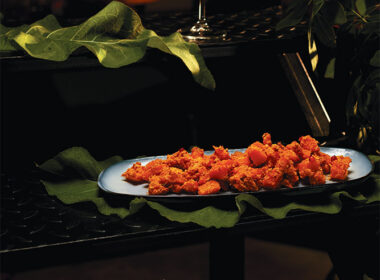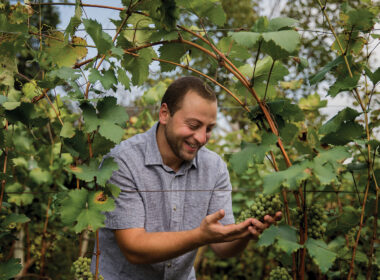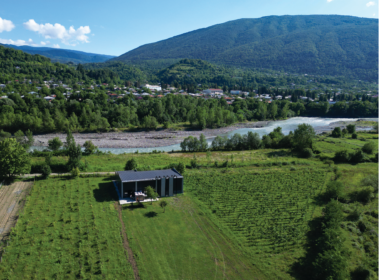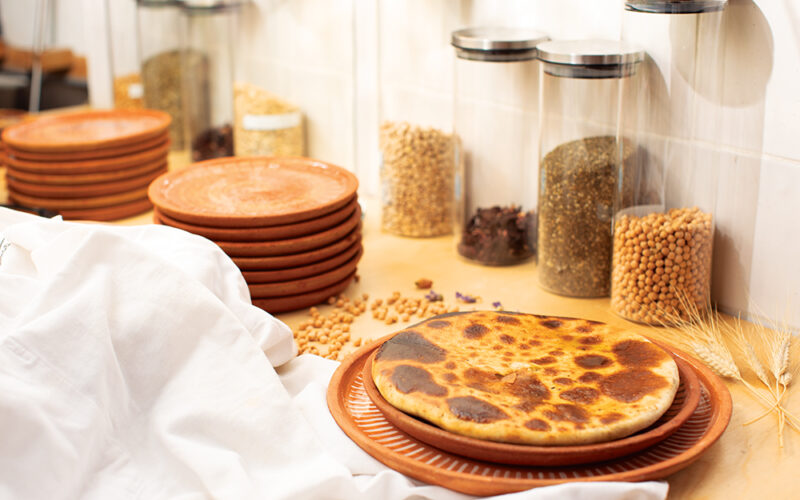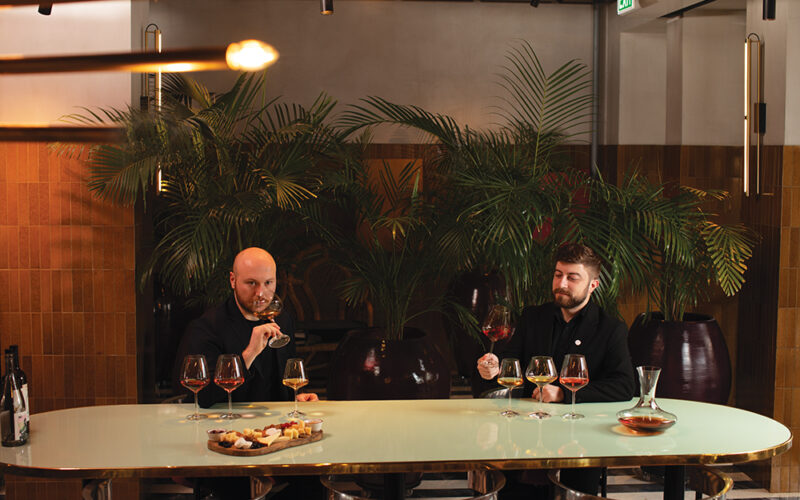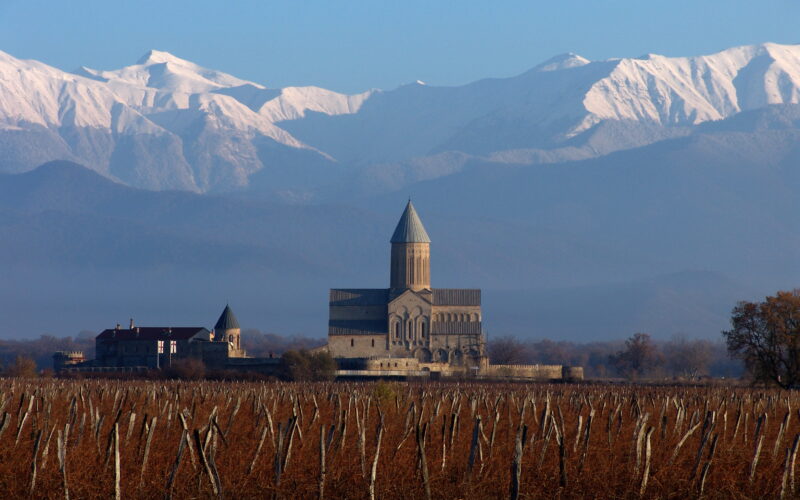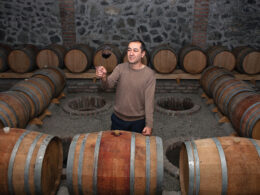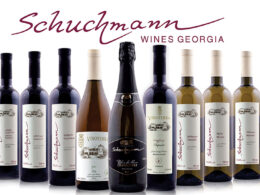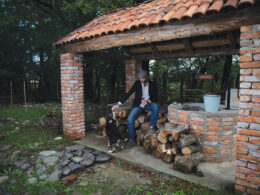| The Rich Tapestry of Stuffed Pastries in Georgian Cuisine |
By Keti Kvichidze
The famous American writer, Darra Goldstein, recently visited Georgia, however, her first visit was in the 1970s, and a few years later, she dedicated her book to the Georgian Supra (traditional Georgian feast). She is the first foreign researcher to write extensively about Georgian cuisine.
After Darra arrived in Tbilisi, I suggested meeting up at the local artisanal sakhachapure (a go-to place for traditional Georgian cheese bread, khachapuri.) In an article published last year in Homeland of Wine about the Saperavi festival in the Finger Lakes region of New York, Darra Goldstein was featured prominently, discussing Georgian cuisine and khachapuri. That’s why I was eager to introduce her to our local stuffed pastries.
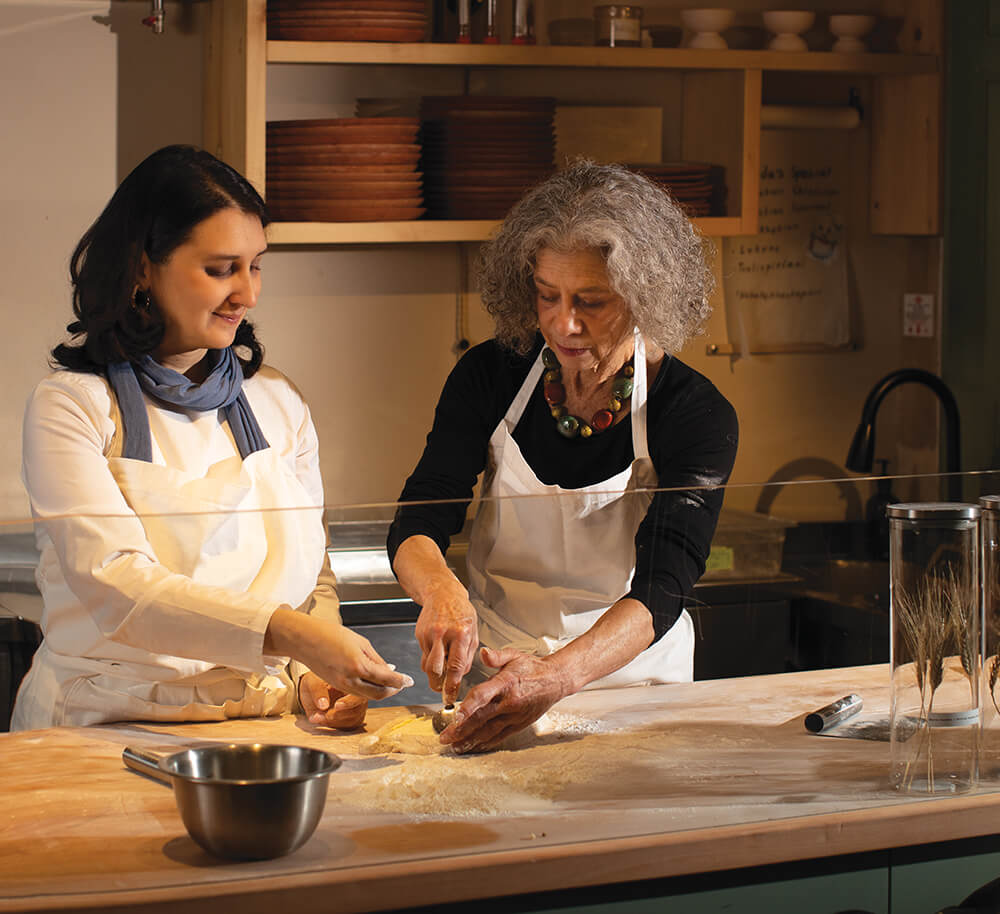
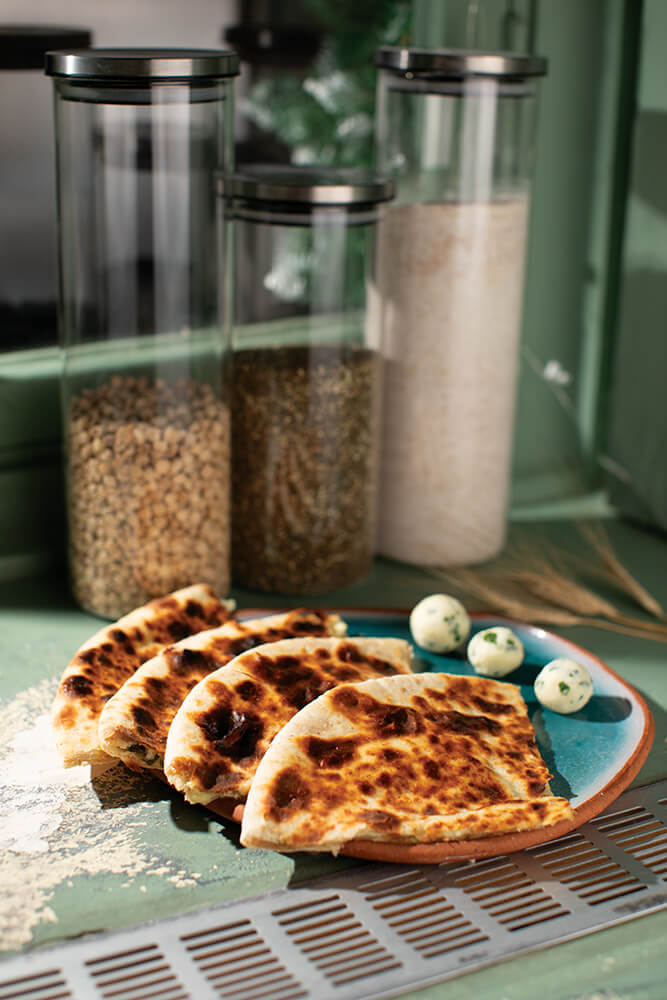
Svanetian Petvraali
The first stuffed pastry that we tasted with Darra, was Svanetian Petvraali. According to Ivane Javakhishvili, millet was one of the most widespread cereal crops in ancient Georgia, known as “petvi” in Georgian, mentioned in both monuments and written sources depicting the life of Eastern and Western Georgia alike. For centuries, millet occupied an important place in agricultural life.
In Laz (the language spoken by the Laz people, who are a Kartvelian (Georgian) ethnic group native to the South Caucasus and mainly live in the Black Sea coastal regions of Turkey and Georgia), this plant is called mchkidi. In Megrelian, it’s referred to as “chkidi”, and in the Svan (language spoken by Svans) language it’s known as “petv” and “petvra” — hence the name “petvraali”. The preparation method is simple: dough kneaded with water, flour, and yeast which is then stuffed with a cheese and millet mix.
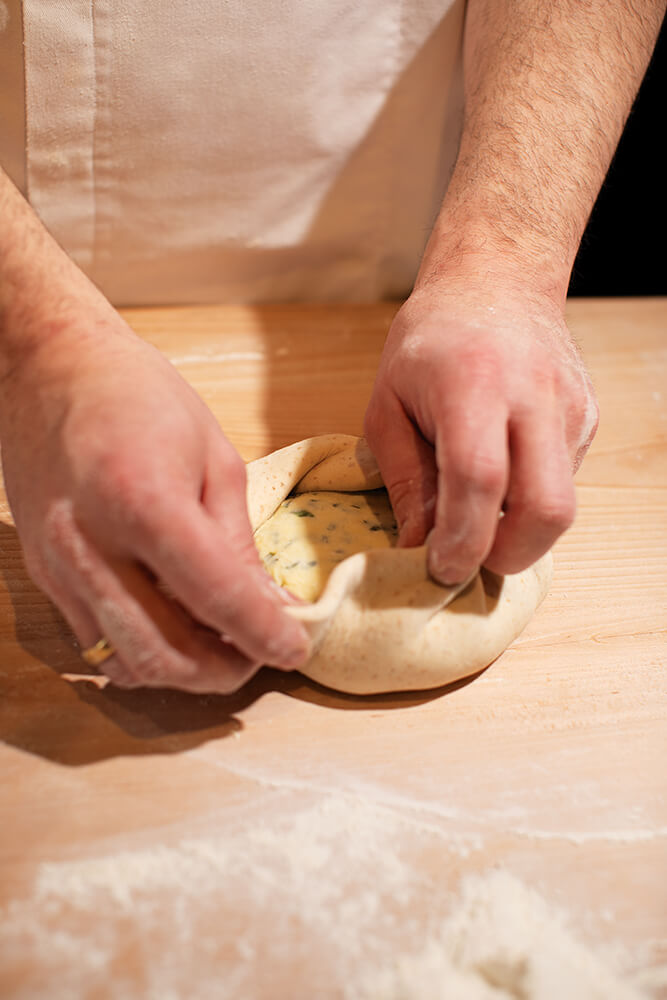
Chakhrakina
This type of stuffed pastry is a staple in Mtiuleti, Pshavi, and the mountainous regions of Eastern Georgia. Its filling consists of beetroot leaves, which are cut and hand-mashed together with cottage cheese. The yeast dough, kneaded in milk, encases the filling before baking.
Ajarian Khachapuri
For Darra, we organized a masterclass on Ajarian (Ajaruli) khachapuri, led by the renowned chef Avtandil Tsetskladze. The Ajaruli khachapuri’s shape, which garners significant interest in the global restaurant industry, is steadily gaining popularity. This stuffed pastry has secured a prominent place on many restaurant menus. Its distinctive boat-like shape has earned it the nickname of cheese boat among foreigners. Chkinti Kveli (Imeruli Cheese) is placed inside a boat-shaped dough and baked in a stone oven. Once baked, the khachapuri is removed, an egg yolk is added to the center, and then it is briefly returned to the oven to pasteurize the egg. Finally, a piece of butter is placed on top of the baked Ajarian khachapuri before serving it to the guest.
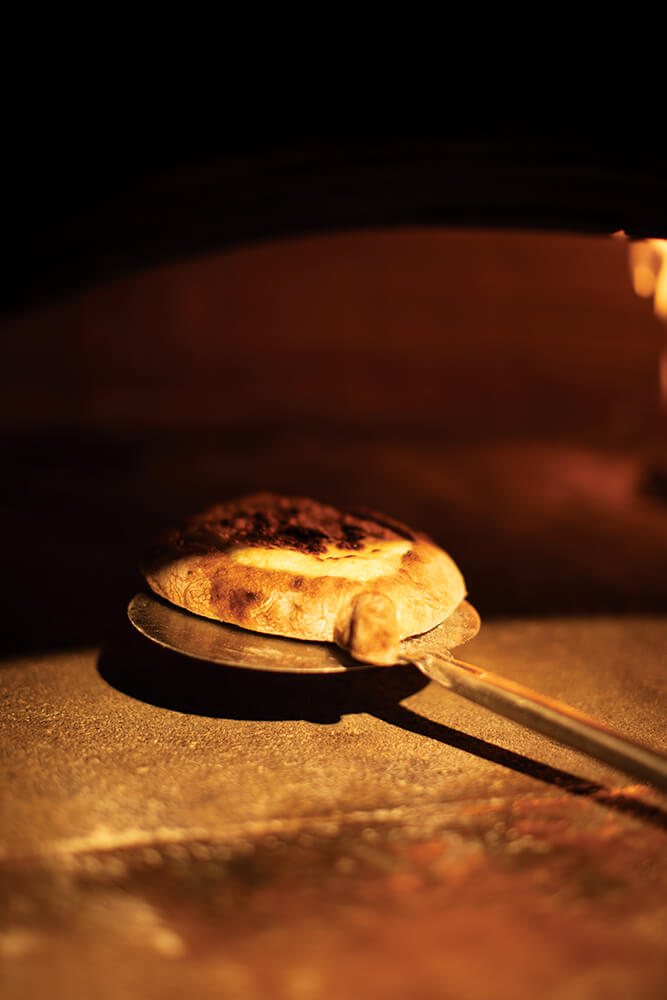
To enjoy it fully, a special technique is required: start by thoroughly mixing/whipping the egg yolk and butter, ensuring they are evenly distributed within the dough. Then, break off a piece, dip it into the filling mixture, and savor each delicious bite. Legend has it that the very first Ajarian khachapuri was baked by a Laz woman awaiting her fisherman husband’s return. With him out at sea, she shaped the dough like a boat, placing an egg yolk in the center as a symbol of the sun and fertility, before baking it.
Lukvne
Darra was particularly intrigued by Lukvne due to its foreign name. Lukvne is prepared in various ways: it involves pre-kneaded maize flour mixed with grated cheese. These mixtures are formed into small balls, placed in the dough, and baked in this manner. A similar dish can also be made using millet, where millet is mixed with grated cheese instead of maize flour.
Lukvne Chagvs consists of wild onions mixed with grated cheese and used as a stuffing. In general, such kneaded flour products are called Lukvne by Svanetians.
Darra was meticulously recording these captivating stories in her small note book, and we took pride in sharing and explaining the details of these once forgotten and now revived stuffed pastries to her.
I also shared with Darra the story of Rachuli Bachuli, Bokhchuani, and the four cheese khachapuri from Ghebi (a village in Racha), which sparked her interest in planning another expedition to Georgia. Bachulis and Bokhchuans are square-shaped khachapuris with slightly pointed corners, resembling a cross. Bachulis are traditionally baked in Racha for Christmas. The culinary traditions of Ghebi deserve their own dedicated story, which we will explore in a future issue of our magazine.
In the realm of stuffed pastries, Racha has solidified its position with the renowned Lobiani. In this region, crushed bean filling is placed into the dough, rolled out, and then a special wooden cutter in the shape of the sun, symbolizing the Borjgali (a Georgian symbol of the sun and eternity), is placed on top to create a distinctive shape on the surface before baking. In ancient times, before beans were introduced to our country, they were baked with Tsulispira (Lathyrus) and called Tsulispiruli.
Meskhetian (Meskhuri) Khachapuri
The hallmark of Meskhetian (Meskhuri) khachapuri lies in its dough—stretchy and elastic. The dough is meticulously rolled out using an Ukhlavi, a special wooden stick, until it reaches a thinness akin to a sheet of paper. The skill of the cook is judged by their adeptness with the Ukhlavi. The delicate dough is then coated with ghee or melted pork fat, rolled, filled with cheese in the center, and baked in this manner.
If we add flour roasted in ghee to the same dough, we will get Meskhetian kada (dessert pie), to which pumpkin seeds can be added for added flavour, resulting in a delightful dessert.
I should also mention Suramian Nazuki (traditional sweet bread) and Kizikian Onion Kadas, which are cherished delights. Nazuki is crafted from bread dough, sometimes soaked in milk, with the addition of raisins for sweetness. Before baking, egg yolk is delicately applied to the surface for a glossy finish, then sugar is poured into burning amber, imparting a distinct burnt sweetness to Nazuki when baked. Similarly, Kizikian Kada is prepared in the Tone (traditional clay baking oven), with onion fried in pork fat serving as its filling. Sugar water is applied over the Kada’s surface before baking.
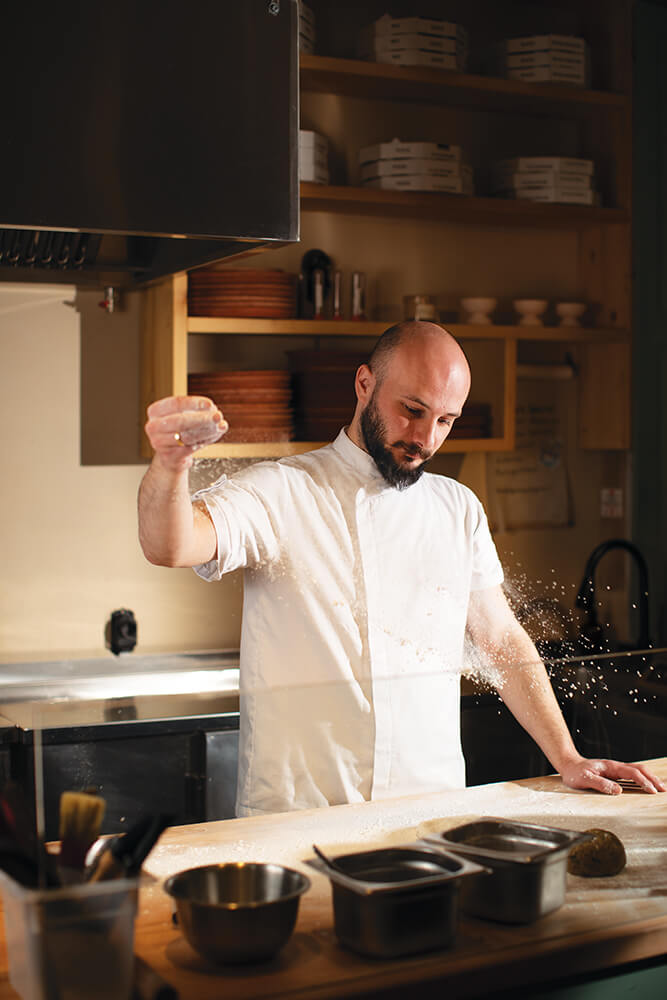
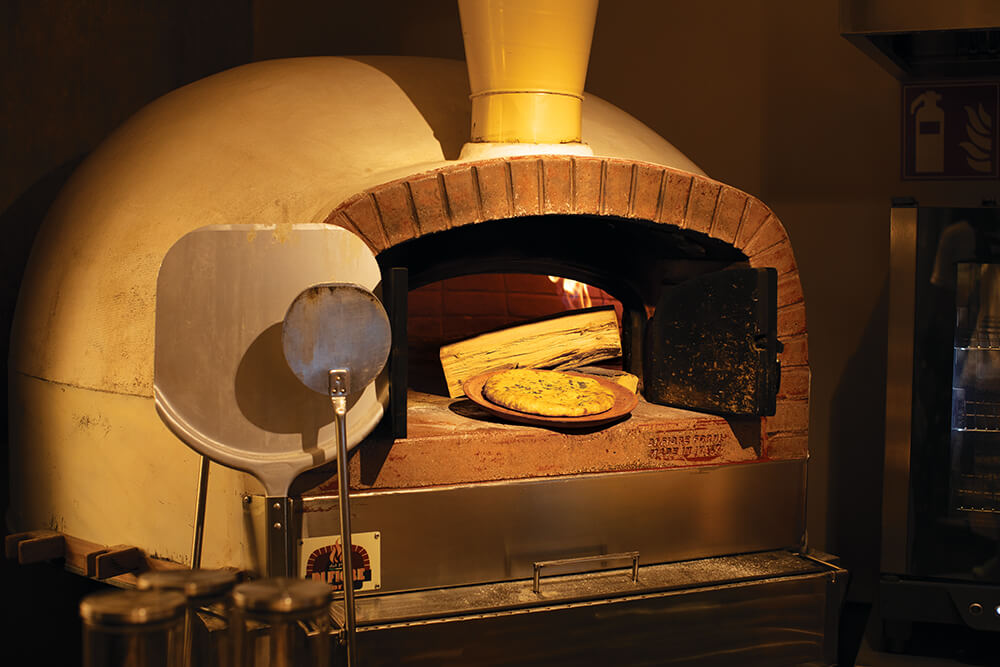
Imeretian (Imeruli) Khachapuri
When discussing stuffed pastries, we mustn’t overlook Imeretian (Imeruli) khachapuri, often hailed as the mother khachapuri. This acclaim is attributed to Dalila Tsatava, a prominent gastronomic researcher who participated in Khachapuri studies.
The key to perfecting Imeretian khachapuri lies in its dough and cheese. Gentle kneading is essential; handling the dough with care and airiness is paramount to achieving authenticity. The cheese selection is crucial, aiming for a slightly stretchy, melty and greasy texture post-baking, The baked khachapuri is ultra thin and allows for easy folding, ensuring a delightful cheese overflow onto your plate.
Gurian Stuffed Pastries
Since Darra’s visit happened to fall during the Christmas period, Chef Avtandil Tsetskhladze also treated us to the renowned Gurulian Ghvezeli—a moon-shaped, stuffed pie consisting of cheese and boiled eggs.
Since we’re discussing Guria, it’s worth mentioning Gurian Brinjula, the origins of which trace back to ancient times, when rice flour was used before rice cultivation became prevalent in the Colchis Lowland. This traditional dish is still cherished in the region. It’s crafted from yeast-free dough, with a mixture of sour cream kneaded into it. This dough is then poured onto a heated Ketsi (traditional clay/stone pan), topped with a blend of soft cheese and egg, and baked to perfection. Gurian Brinjula is a beloved everyday khachapuri, prized for its soft, fluffy texture, and notably, its dough requires no resting period.
Together with Darra, we savored Kotori – Tushetian (Tushuri) khachapuri, crafted from yeast-free dough and featuring the distinctive Kalti (hard, aged, cow’s milk cheese, produced in the highlands of Georgian Tusheti) filling. We provided detailed insight into this delicacy in the previous edition of the magazine.
We tried Megrelian khachapuri, a popular dish in Megrelian cuisine that comes in various styles, from boiled, to baked on a stone pan. This stuffed pastry is topped with a mix of cheese and egg yolk, baked until it shines like the sun, bringing warmth to both heart and soul.
Moved by the heartwarming welcome she had received from our team, Darra said goodbye to us, taking many new ideas and plans with her. Until her new release.
გულსართიანებით მდიდარი ქართული სამზარეულო
საქართველოს ცნობილი ამერიკელი მწერალი დარა გოლშტეინი სტუმრობდა. ჩვენს ქვეყანაში დარამ პირველად გასული საუკუნის 70-იან წლებში იმოგზაურა და რამდენიმე წელში, ქართულ სუფრას წიგნიც მიუძღვნა. ის პირველი უცხოელი მკვლევარია, ვინც ქართულ სამზარეულოზე დაწერა.
თბილისში ჩამოსულ დარას შეხვედრა არტიზანულ სახაჭაპურეში დავუთქვი. სტატიაში, რომელიც გასულ წელს Homeland of Wine-ში გამოქვეყნდა და რომელიც ფინგერ ლეიკსის შტატში ჩატარებული საფერავის ფესტივალის შესახებ წერდა, ერთ-ერთი გმირი სწორედ დარა გოლდშტეინი გახლდათ. ის ქართულ სამზარეულოზე და ხაჭაპურზე საუბრობდა. სწორედ ამიტომ გადავწყვიტე მისთვის ჩვენი გულსართიანები გამეცნო.
სვანური ფეტვრაალი
პირველი გულსართიანი, რომელიც დარასთან ერთად დავაგემოვნეთ სვანური ფეტვრაალი იყო. ივანე ჯავახიშვილის განმარტებით, ძველ საქართველოში, ფეტვი ერთ-ერთი ფართოდ გავრცელებული მარცვლეული კულტურა იყო. „ფეტჳ“ იხსენიება, როგორც აღმოსავლეთ, ისე დასავლეთ საქართველოს ყოფა-ცხოვრების ამსახველ ძეგლებსა და წერილობით წყაროებში. საუკუნეების განმავლობაში, ფეტვი მნიშვნელოვან ადგილს იკავებდა სამეურნეო ყოფაში. ლაზურად ამ მცენარეს ეწოდება „მჭკიდი“, ჭანურად – „მ-ჭკუდი“, მეგრულად – „ჭკიდი“ სვანურად კი – „ფეტვ“ და „ფეტვრა“ – სწორედ აქედან გვაქვს სახელწოდება „ფეტვრაალიც“. მისი მომზადების წესი მარტივია: გვესაჭიროება წყალზე, ფქვილსა და საფუარზე მოზელილი ცომი, ჭყინტი ყველი და ფეტვი, რომელიც ყველთან ერთად უნდა ავურიოთ და გამოვიყენოთ გულსართად.
ჭახრაკინა
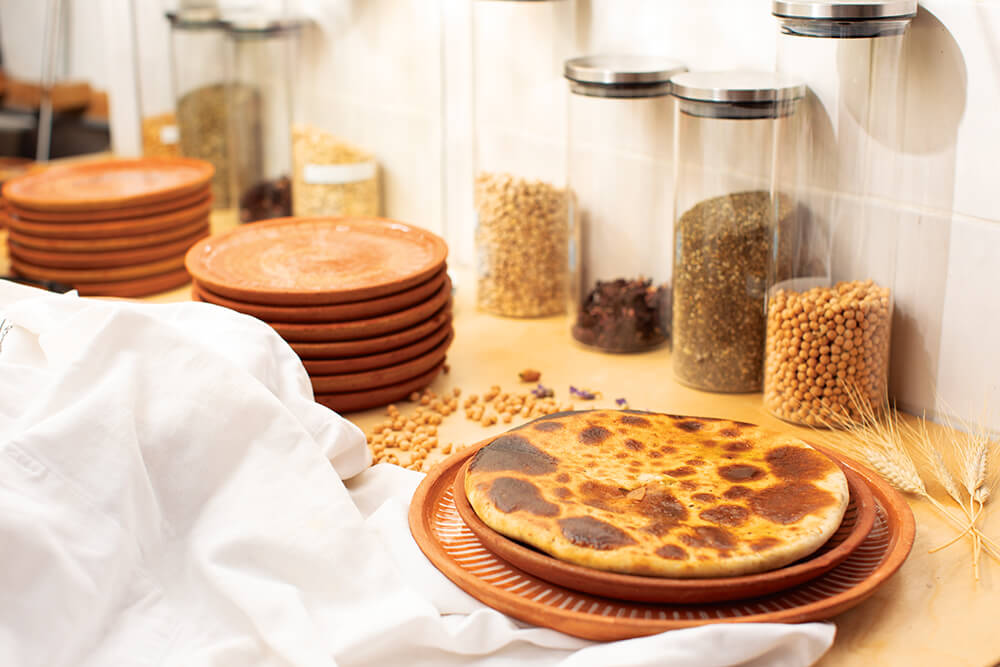
ამ გულსართიანს მთიულეთში, ფშავში და აღმოსავლეთ საქართველოს მთიან ნაწილში შეხვდებით. მისი შიგთავსი ჭარხლის ფოთლებისგან მზადდება: უმ ფოთლებს დაჭრიან, ხელით მოსრესენ ხაჭოსთან ერთად, საფუარიან ცომს რძეში მოზელენ, შიგნით ჩადებენ გულსარს და ისე გამოცხობენ.
აჭარული ხაჭაპური
დარასთვის გავმართეთ აჭარული ხაჭაპურის მასტერკლასი, რომელიც ბრენდშეფმა ავთანდილ ცეცხლაძემ ითავა.
აჭარულის ფორმა, რომელიც მსოფლიო სარესტორნო ბიზნესში დიდ ინტერეს იწვევს, დღითიდღე პოპულარული ხდება. ამ გულსართიანს უკვე არაერთ რესტორანში უკავია წამყვანი პოზიცია. მისი ფორმა ნავს მოგვაგონებს, ამიტომ უცხოელები მას „ყველის ნავსაც“ უწოდებენ.
ნავის ფორმის ცომში ჭყინტი ყველი იდება და ქვის ღუმლში ცხვება. გამომცხვარ ხაჭაპურს გამოიღებენ, შუაგულში კვერცხის გულს ჩადებენ, შემდეგ რამდენიმე წამით შეაბრუნებენ ღუმელში, რათა კვერცხის პასტერიცაზია მოხდეს. გამომცხვარ აჭარულ ხაჭაპურს ზემოდან კარაქის ნაჭერს დაადებენ და ისე მიართმევენ სტუმარს.
მისი ჭამა თავისებურ ტექნიკას მოითხოვს: პირველ რიგში, კვერცხის გული და კარაქი ერთმანეთში უნდა აურიოთ/ათქვიფოთ და კარგად გადაანაწილოთ ცომში, შემდგომ ყუა მოატეხოთ, ამოაწოთ შიგთავსის მასაში და გემრიელად მიირთვათ.

ლეგენდის თანახმად, აჭარულ ხაჭაპური პირველად ლაზმა ქალმა მოამზადა, რომელიც მეთევზე ქმარს სახლში ელოდა. ქმარი ზღვაში ნავით იყო გასული, ამიტომაც ცომს ნავის ფორმა მისცა, შუაში კვერცხის გული მზისა და ნაყოფიერების სიმბოლოდ ჩადო და ისე გამოაცხო.
ლუკვნე
დარას განსაკუთრებული ინტერესი, უცხო სახელწოდებიდან გამომდინარე, ლუკვნემ გამოიწვია. ლუკვნე სხვადასხვანაირად მზადდება: ეს გახლავთ დაფშვნილ ყველში შეზავებული წინასწარ კარგად მოზელილი სიმინდის ფქვილი. ამ გულსართისგან პატარა გუნდებს ამზადებენ, ცომში ჩადებენ და ისე აცხობენ. იგივე შეიძლება მომზადდეს ფეტვითაც (სიმინდის ფქვილის ნაცვლად ფეტვი ერევა დაფშვნილ ყველთან). ლუკვნე ჭაგვს – ეს არის დაფშვნილ ყველში გადაზავებული ველური ხახვი, რომელიც გამოიყენება გულსართად. ზოგადად, ასეთ გადაზელილ ფქვილიან ნაწარმს სვანები ლუკვნეს უწოდებენ.
ამ საინტერესო ისტორიებს დარა თავის პატარა წიგნაკში საგულდაგულად ინიშნავდა, ჩვენ კი სიამაყით ვუყვებოდით და ვუხსნიდით მივიწყებული და გაცოცხლებული გულსართიანების დეტალების შესახებ.

დარას რაჭული ბაჭულის, ბოხჩუანის და ღების (კუთხე რაჭაში) ოთხი ყველის ხაჭაპურის შესახებაც მოვუყევი, რამაც კიდევ ერთხელ მოანდომა საქართველოში ექსპედიციის დაგეგმვა. ბაჭულები და ბოხჩუანები ოთხკუთხედი ფორმის ხაჭაპურებია, კუთხეები ოდნავ წაწვეტებული აქვს, რაც ჯვრის ფორმას აძლევს. ბაჭულები რაჭაში საშობაოდ ცხვება. ღების კულინარია აუცილებლად ცალკე მოსაყოლია და მას ჩვენი ჟურნალის რომელიმე ნომერში აუცილებლად მივუბრუნდებით.
გულსართიანებში რაჭამ თავისი ადგილი სახელგანთქმული ლობიანით დაიმკვიდრა. ამ კუთხეში, შეკმაზული ლობიოს გულსართს ცომში ჩადებენ, გააბრტყელებენ, ზემოდან მზის ფორმის ხის სპეციალურ საჭრელს დაადებენ, რათა ზედაპირზე ბორჯღალის ფორმა გამოისახოს და ისე გამოაცხობენ. ძველ დროში, სანამ ჩვენს ქვეყანაში ლობიო შემოვიდოდა, მას ცულისპირათი (მარცვლეული კულტურა) აცხობდნენ და „ცულისპირულს“ უწოდებდნენ.
მესხური ხაჭაპური
მესხური ხაჭაპურში მთავარი მისი ცომია – წელვადი და ელასტიური. ცომი უხლავით, ხის სპეციალური გრძელი ჯოხით „გაყავთ“, ანუ აბრტყელებენ, ვიდრე ქაღალდის ფურცელივით თხელი არ გახდება. მზარეულის ხელოვნება სწორედ უხლავის კარგი ხმარებით ფასდება. თხელ ცომს ერბოს ან გამდნარ ღორის ქონს წაუსმევენ, დააგორგოლებენ, შუაში ყველს ჩადებენ და ისე აცხობენ. იგივე ცომში ერბოში მოხალული ფქვილი რომ ჩავდოთ, მესხურ ქადას მივიღებთ, რომელსაც გემოსთვის შეგიძლიათ, გოგრის კურკები მოაყაროთ და დესერტიც შესანიშნავი გამოვა.
აქვე უნდა ვახსენო სურამის ნაზუქი და ქიზიყური ხახვიანი ქადები, რომელთა მირთმევას არაფერი სჯობს. ნაზუქს პურის ცომისგან ამზადებენ, რომელსაც ზოგჯერ რძეში გადაზელენ, სიტკბოსთვის ქიშმიშს დაუმატებენ, სიპრიალისთვის ზედაპირზე კვერცხის გულს გადაუსვამენ და ისე გამოაცხობენ თონეში. ნაკვერჩხალში შაქარს ჩაყრიან, რომელიც მობრაწვისას დამწვარ, ტკბილ და თავისებურ არომატს აძლევს ნაზუქს. ქიზიყური ქადაც თონეში ცხვება. მის გულსართად ღორის ქონში გადაზელილი ხახვი გამოიყენება. ქადას ზედაპირზე ტკბილ წყალს გადაუსვმენ და ისე აცხობენ.
იმერული ხაჭაპური
გულსართიანებზე საუბრისას არ შეიძლება არ შევეხოთ იმერულ ხაჭაპურს. მას ხომ “დედა ხაჭაპურს” ეძახიან (დალილა ცატავა – გასტრონომიული მკვლევარი, ხაჭაპურის კვლევის ერთერთი მონაწილე).
იმერული ხაჭაპურის მთავარი საიდუმლო მისი ცომი და ყველია. თუ ცომის ზელვას სათუთად არ მიუდგებით, ხელის მოძრაობით ნაზად და ჰაეროვნად არ შეეხებით ცომს, ჩათვალეთ, რომ ნამდვილი იმერული ხაჭაპური არ გამოგივათ. სპეციალურად ირჩევა ყველიც, რომლის სტრუქტურაც გამოცხობის შემდეგ ოდნავ წელვადი, თან მდნარი და ცხიმიანი უნდა იყოს. გამომცხვარი ხაჭაპური კი უთხელესია, ადვილად გადაკეცავთ, ყველი კი აუცილებლად დაიღვენთება თქვენს თეფშზე.
გურული გულსართიანები
რადგან დარას სტუმრობა საშობაო პერიოდს დაემთხვა, შეფმა ავთანდილ ცეცხლაძემ ცნობილი გურული ღვეზელიც გამოგვიცხო – მთვარის ფორმის გულსართიანი, რომლის შიგთავსიც ყველისა და მოხარშული კვერცხისგან მზადდება.
რადგან გურიას შევეხეთ, აქვე უნდა ავღნიშნო გურული ბრინჯულა, რომელიც ძველ დროში ბრინჯის ფქვილგან მზადებოდა, მანამ სანამ კოლხეთის დაბლობზე ბრინჯი მოყავდათ. ეს გულსართიანი ამ მხარეში ახლაც შემორჩენილია. ის უსაფუარო ცომისგან მზადდება, არაჟნით მოზელილი ცომის მასას გახურებულ ქვის კეცზე დაასხამენ, ზემოდან კვერცხში არეულ ჭყინტ ყველს მოაყრიან და ისე გამოცხობენ. ეს ნაზი, ფაფუკი, ყოველდღიური მოხმარების სახელდახელო ხაჭაპურია, რომლის ცომსაც არ სჭირდება დასვენება.

დარასთან ერთად დავაგემოვნეთ კოტორიც, უსაფუარო ცომისგან მომზადებული თუშური ხაჭაპური, კალტის გულსართით. მის შესახებ ჟურნალის წინა ნომერში დეტალურად გიამბეთ (კოტორისა და თუშური სამზარეულოს შესახებ ვრცლად შეგიძლიათ წაიკითხოთ ჩვენს ვებ-გვერდზე).
გავსინჯეთ მეგრული ხაჭაპური. ამ კუთხის სამზარეულოში რამდენიმე სახეობის ხაჭაპური გვხვდება – მოხარშულიდან ქვის კეცზე მობრაწულამდე. მეგრულ ხაჭაპურს ზემოდან კვერცხის გულში არეული ყველი აყრია და ისე ცხვება, მზესავით ანათებს და გულს და სულს გითბობთ.
ჩვენი გუნდის დახვედრით გულგამთბარი დარა ახალი იდეებით და გეგმებთ დაგვემშვიდობა, მომავალ ახალ წიგნამდე.

